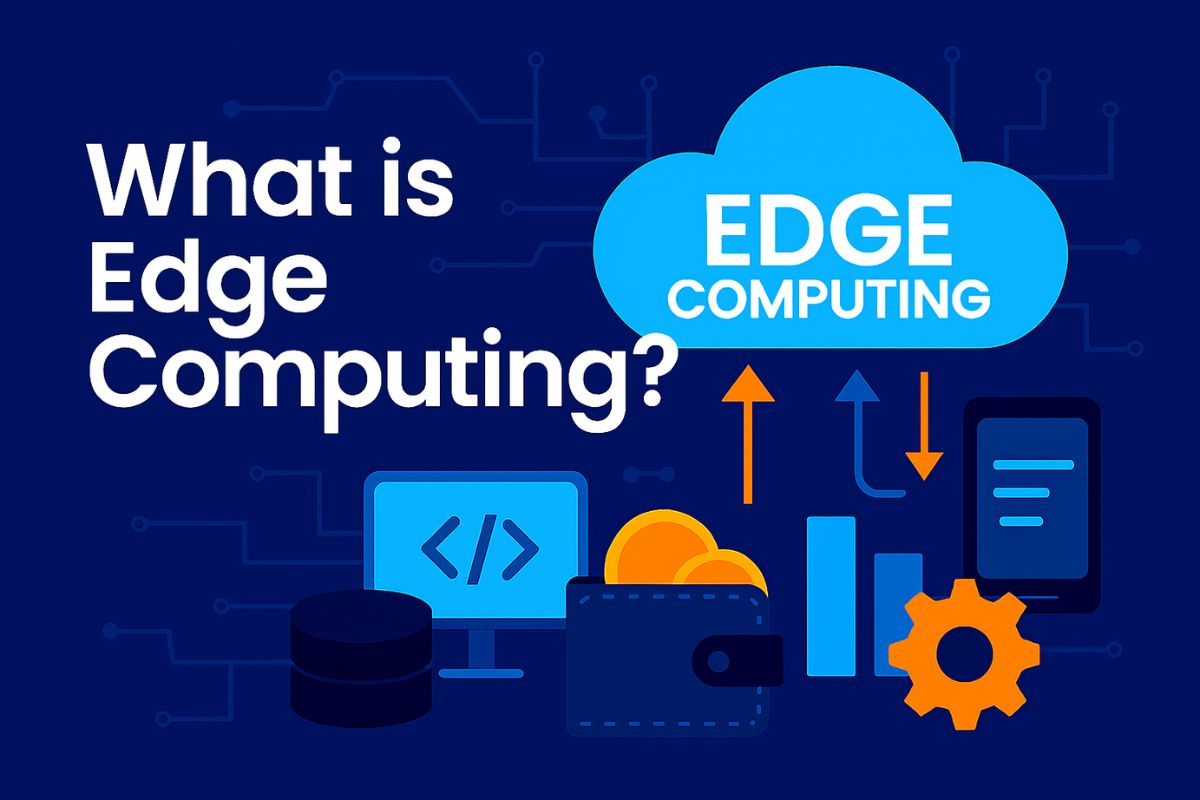Edge Computing is a distributed computing model that brings computation and data storage closer to the location where it’s needed — at the “edge” of the network. This reduces latency, improves speed, and enhances real-time data processing. Learn how edge computing works, how it compares to cloud computing, its real-world applications, benefits, and impact across industries like healthcare, manufacturing, and education.
In today’s digital world, speed matters more than ever. Whether it’s an autonomous vehicle making a life-saving decision or a student using AR to study human anatomy — milliseconds can make a big difference.
That’s where Edge Computing comes in.
Edge computing is reshaping how data is processed, stored, and delivered — especially for applications that require real-time action. In this blog, we’ll break down what edge computing is, how it works, why it matters, and how it differs from cloud computing — all in simple yet professional language.
What is Edge Computing?
Edge computing is a distributed computing architecture where data processing and analysis happen close to the source of data generation, instead of relying entirely on centralized cloud servers.
In simple terms:
Instead of sending data to a distant cloud data center, edge computing processes it locally — right near the device or sensor that created it.
How Does Edge Computing Work?
Devices at the Edge
These can include:
- Smart sensors
- IoT devices (smart home appliances, wearables)
- Industrial machines
- Mobile phones
- Edge gateways
Local Processing Units
These devices are connected to edge nodes — local computing resources that can perform tasks like data filtering, analysis, and real-time decision-making.
Connection to Cloud
While edge handles real-time tasks locally, non-critical or bulk data can still be sent to the cloud for long-term storage or deeper analysis.
Benefits of Edge Computing
| Benefit | Explanation |
|---|---|
| Low Latency | Reduces delay by processing data close to the source |
| Bandwidth Savings | Reduces data sent to central servers |
| Enhanced Privacy | Keeps sensitive data local (great for healthcare/finance) |
| Reliability | Keeps operations running even with poor internet |
| Real-Time Insights | Enables instant decision-making |
Real-Life Applications of Edge Computing
1. Autonomous Vehicles
Edge computing helps self-driving cars process sensor data in real time, making split-second decisions.
2. Healthcare
- Wearable health monitors track vitals and alert doctors instantly.
- Remote surgery systems process video streams locally for zero-lag performance.
3. Smart Manufacturing
- Machines predict failures before they happen.
- Data from factory equipment is analyzed at the edge for real-time automation.
4. Smart Cities
- Traffic lights adjust based on vehicle flow.
- CCTV and sensors detect crimes or anomalies instantly.
5. EdTech & Online Learning
- Augmented Reality (AR) apps for biology, geography, etc.
- Real-time data syncing in classrooms with poor internet.
Edge vs Cloud vs Fog Computing
| Feature | Cloud Computing | Edge Computing | Fog Computing |
|---|---|---|---|
| Location | Centralized data centers | Close to data source | Between edge & cloud |
| Latency | High | Low | Moderate |
| Processing Power | High | Moderate to High | Varies |
| Bandwidth Usage | High | Low | Moderate |
| Best Use Case | Big data storage, analytics | Real-time decision-making | Industrial automation |
Edge Computing vs Cloud Computing
| Feature | Cloud Computing | Edge Computing |
|---|---|---|
| Where Data is Processed | Central servers | Local devices or edge nodes |
| Latency | Higher | Lower (near-instant) |
| Internet Dependency | Always needed | Can work offline |
| Use Cases | Storage, ML training | IoT, real-time apps |
Conclusion: Edge doesn’t replace cloud — it complements it. Together, they create a hybrid model for optimal performance.
Edge Computing in India
India’s digital growth is fueling the adoption of edge technologies, especially in:
Telecom
- Jio and Airtel are exploring edge + 5G to power smart cities and AR apps.
Healthcare
- Startups use edge devices for remote diagnostics in rural areas.
Agriculture
- Smart irrigation systems and crop monitoring with edge sensors.
Enterprises
- Retail chains use edge computing for inventory tracking and real-time pricing.
Edge Computing Tools & Platforms
| Tool/Platform | Description |
|---|---|
| AWS IoT Greengrass | Extends AWS to edge devices |
| Microsoft Azure Edge Zones | Brings Azure services closer to users |
| Google Distributed Cloud Edge | AI + Edge computing for telcos and retail |
| NVIDIA Jetson | AI computing platform for edge devices |
| EdgeX Foundry | Open-source framework for edge solutions |
Expert Tips & Common Mistakes
Expert Tips
- Use edge only where real-time processing is essential.
- Combine edge with cloud for hybrid efficiency.
- Always encrypt edge devices to prevent data theft.
Common Mistakes
- Overuse of Edge: Not all applications need it.
- Neglecting Updates: Edge devices need security updates too.
- Ignoring Compatibility: Not all software supports edge deployment.
Career Opportunities in Edge Computing
Edge computing is creating new job roles in:
- IoT Development
- Edge Network Engineering
- Real-time Data Analysts
- Embedded Systems Design
- Edge AI Developers
Job demand is growing in industries like automotive, healthcare, smart infrastructure, and defense.
Conclusion
Edge computing is not just a tech trend — it’s the foundation of a faster, smarter, and more responsive digital world. By bringing computing closer to where data is created, edge unlocks new possibilities in healthcare, education, manufacturing, and beyond.
Whether you’re a student, entrepreneur, or IT professional, understanding what edge computing is will help you stay relevant in the evolving tech ecosystem.
Liked this post? Share it, leave a comment, or check out our related tech explainers below!
FAQs
1. What is edge computing in simple words?
Edge computing is a way of processing data near the place where it’s generated, instead of sending it far away to a central cloud.
2. How is edge computing different from cloud computing?
Edge computing happens locally and reduces delay. Cloud computing happens in central servers and needs a strong internet connection.
3. What are the benefits of edge computing?
It offers faster data processing, better security, reduced bandwidth use, and real-time decision-making.
4. Is edge computing the future?
Yes, especially with the growth of 5G, IoT, and real-time applications like self-driving cars and smart cities.
5. Does edge computing work without the internet?
Yes, many edge devices can work offline and sync data later.
6. What industries use edge computing?
Healthcare, automotive, retail, manufacturing, education, and agriculture are some of the key sectors.
7. What skills do I need for a career in edge computing?
Knowledge of IoT, embedded systems, data analytics, networking, and security is essential.



